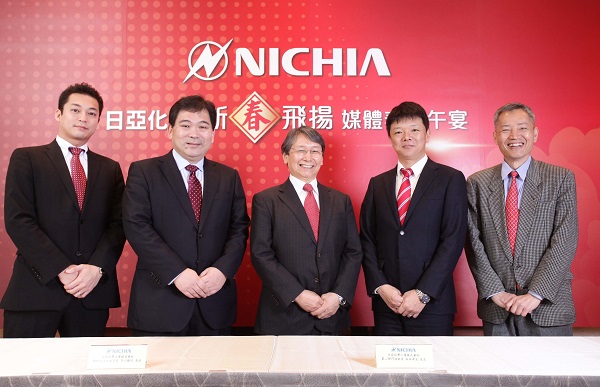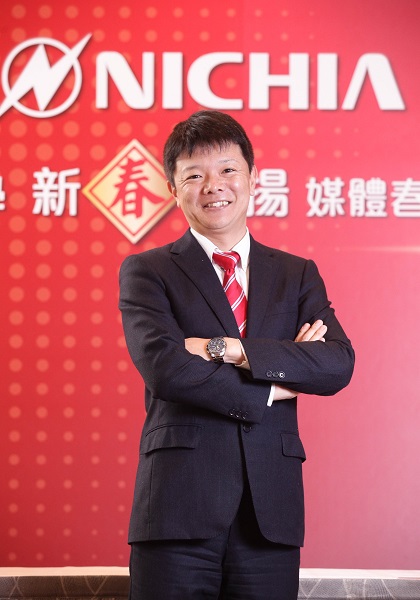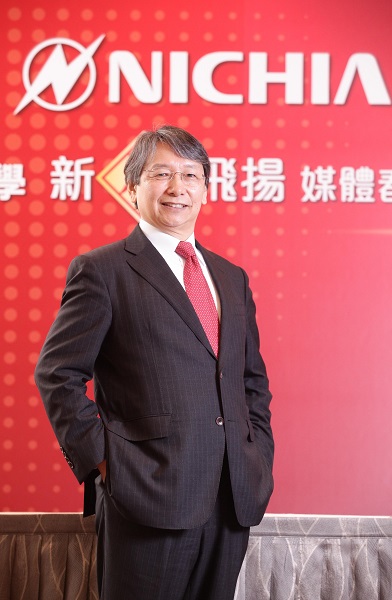Leading global LED manufacturer Nichia’s product lineup for 2015 will include UV LEDs, Mn 4+red phosphor powder, and laser diode products, company representatives revealed at a recent press conference at Hotel Okura in Taipei, Taiwan.
The Japanese manufacturer reported two digit growth in 2014, and has an optimistic outlook for this year, especially in the development of high-end products and automobile lighting sector.
“We estimate revenues from the car market sector to grow about 30%, but in the general lighting and backlight market revenues might not be profitable, as overt market competition drives down retail prices,” said Katsuyuki Akutagawa, Chief Legal & IP Officer and Company Board Director, Legal and Intellectual Property Division, Nichia.
 |
|
Nichia officials: Yuto Iwasa, Assistant Research Scientist, Intellectual Property Dept., Legal & Intellectual Property Division, Administration Unit, Hinori Takagi, General Manager, Intellecutal Property Department, Legal and Intellectual Property Dept., Legal & Intellectual property Division Administration Unit, Katsuyuki Akutagawa, Chief Legal & IP Officer and Company Board Director, Dr. Takashi Sakamoto, Principal Technical Officer, Optoelectronics Products BU., and Masaki Mukaiyama, Special Consultant and Spokesperson, Nichia Taiwan. (All photos courtesy of Nichia)
|
Nichia to highlight red phosphor powder technology in 2015
In the backlight application sector, Nichia will be focusing on Mn 4+ red phosphor technology to boost LCD image quality, said Takashi Sakamoto, Principal Technical Officer, Optoelectronics Products BU, Nichia. Nichia is increasingly prioritizing lighting quality over brightness in backlight products, Sakamoto added. A new red phosphor product is in the making, and will be launched on the market in 2015.
Aside from TV backlight applications, the company has introduced red phosphor technology into smartphones, but Sakamoto remained mum on details.
Market rumors in Asia last February pointed Nichia would be focusing on Mn 4+ red phosphor technology, since its white YAG phosphor patent term had expired.Five months later, GE Lighting announced licensing its red phosphor powder patent for TV display applications to Nichia and Sharp. Sakamoto confirmed the company has employed GE’s red phosphor technology in LED displays, and that its LED backlight products benefited from the partnership.
He also upheld a positive outlook for red phosphor powder applications. “There is still room for red phosphor powder applications in small, mid-sized and even large TV panels,” said Sakamoto. “We estimate the penetration rate of red phosphor products in Nichia backlight products will reach about 20% to 30%.”
 |
|
Dr. Takashi Sakamoto, Principal Technical Officer, Optoelectronics Products BU, Nichia poses for a company photo shoot. |
Nichia to deliver new UV LED product this spring
Global UV LED manufacturer, Nichia, is also keeping up with UV market trends. The UV LED market has become a booming application market this year, and the company is increasingly valuing medical and industrial applications, said Katsuyuki Akutagawa, Chief Legal & IP Officer and Company Board Director, Legal and Intellectual Property Division, Nichia.
 |
|
Katsuyuki Akutagawa, Chief Legal & IP Officer and Company Board Director of Nichia. |
Laser diode shines light ahead for Nichia
Laser diodes have emerged as a potential LED replacement in recent years, with some industry lighting experts, such as Nobel Physics laureate Shuji Nakamura delving into this sector’s research. At CES 2015 this year, German automobile maker BMW introduced advanced laser lighting technology into headlights for the first time. Asked if Nichia had similar product development plans, Akutagawa commented the company already had basic patents for automotive laser lighting projections.
Aside from exterior car lights, Nichia has introduced laser technology into vehicle head-up display systems (HUD) last year. In June 2014, the company launched a new green and blue laser HUD system. The company will be launching a next generation product by October this year, said Sakamoto.
The shift from red laser technology to blue and green laser is a significant transition for the company. “Nichia already has a very comprehensive red laser patent portfolio, and we are currently developing and expanding our blue and green laser patent portfolio,” said Akutagawa. “In addition, blue and green laser technology will become very important with the release of new TV standards by 2020.”
Nichia has a 70% of global market share in the laser market, with German LED manufacturer Osram trailing in second, said Masaki Mukaiyama, Special Consultant and Spokesperson, Nichia Taiwan, adding “There is basically no competition for Nichia in this market sector.”
Aside from automotive and TV applications, the company’s laser products can already be found in overhead projectors, said Mukaiyama.
Nichia has developed laser diodes in next generation endoscopes, said Mukaiyama. The new endoscopes are operated differently from traditional devices to minimize discomfort, and are inserted through the nose rather than the throat, hence reducing vomit and gag reflexes caused by traditional endoscopic methods. According to Mukaiyama, the new method is also relatively painless. “The new laser endoscopes have been well received in Japanese hospitals with most patients preferring the new endoscope,” said Mukaiyama.
As the LED industry competition intensifies, Nichia is differentiating itself from market competition with advanced lighting technology. By injecting large sums into R&D annually, the company hopes to maintain its market position in high-end lighting applications. To sum up, Nichia’s product line up for 2015 will consist of four major products ultra-small flip chip LEDs; red phosphor powder; UV LEDs; and new laser products.
(Author: Judy Lin, Chief Editor, LEDinside)
(Editorial Note: A paragraph about Nichia's UV LED endoscope developed with Fujifilm has been moved to second to last paragraph, Fujifilm's involvement has also been removed. The endoscope was developed with laser diode technology and not UV LED as previously mentioned. The changes were made on March 16, 2015.)














